Experimental fighter-interceptor I-270
Therefore, the People's Commissariat of the aviation industry did not wait for proposals from the military about copying Me-163, but tried to "deliver a preemptive strike." The plan for the construction of prototype aircraft on 1946 year, approved by 26 February 1946 of the year by resolution SNK No. 472-193, included two almost identical design tasks for rocket interceptors.
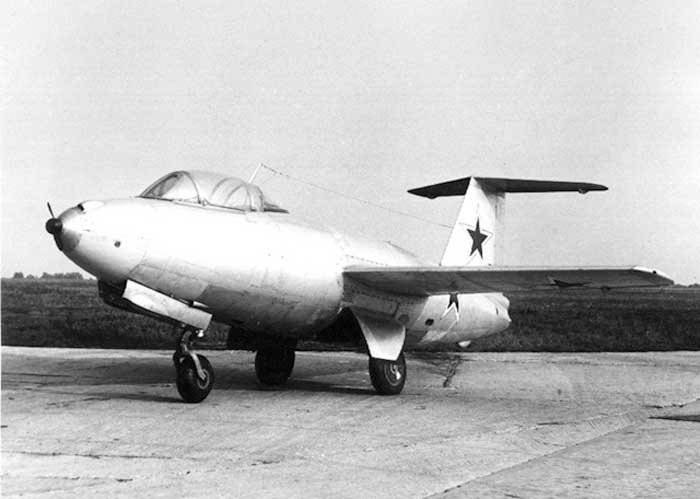
Experimental Design Bureau A.I. Mikoyan (OKB-155) was instructed to design and build a single-seat interceptor fighter with a high-altitude cabin, a liquid-propellant rocket engine and the following flight-tactical characteristics: the maximum speed of the earth was 1100 kilometers per hour (M = 0,895), the maximum speed at an altitude of 10 thousand m - 1000 km / h (M = 0,93), flight time at the minimum thrust - 18 min., at the maximum thrust - 5 min., ceiling for the remaining fuel at 1,2 min. - 17 thousand m, the rise time to the height of 17 thousand m - 3,2 min., Armament - two guns of 23 caliber of a millimeter. The deadline for presenting the first copy for flight tests is November 1 1946 of the year.
Here is how the situation with the design of the rocket fighter-interceptor I-270 was described in the report of Plant No. 155 (OKB-155 Mikoyan) for 1946 a year:
“In the initial design of the aircraft, the swept wing was envisaged. After the calculations and research carried out by TsAGI, insufficient data were found for the detailed design of such a wing, which caused a complete revision of the aircraft design using the direct 9-percentage wing (March 1946 of the year). Further study of the Central Aerohydrodynamic Institute revealed the impossibility of obtaining a sufficient amount of basic data for an aircraft with this wing. The work was stopped, the project was revised again under the 12 percent wing (April 1946 of the year). In the future, work was hampered by obtaining aerodynamic and strength data for this wing. On wing geometry, the final recommendations endorsed August 8. ”
The Mikoyan Design Bureau, in contrast to the Lavochkin Design Bureau, preferred to use the traditional cannon weapon. On the I-270 plane, they decided to install two NS-23 guns (115P) of caliber 23 mm with 40 ammunition ammunition and two four-barreled launchers (as in German) for firing rockets.
Unlike Lavochkin, Mikoyan did not refuse to build his own rocket fighter-interceptor I-270. Work on this fighter began in November 1945 of the year. The fighter was designed for air defense units of military bases and large industrial facilities. By the end of March next year, the development of the layout of the machine, which received the factory code “Ж”, was completed. After that, the production of drawings for the layout began.
In April, Belyaev V.M. was appointed lead engineer for the aircraft. On the recommendation of TsAGI in the same month extended the nose of the fuselage. This was done to give a more streamlined aerodynamic shape. The model was made by mid-May, and 17 numbers by representatives of the State Aircraft Research Institute of the Air Force held its preliminary inspection. In connection with their comments, the layout was finalized. The draft design of the aircraft was ready at the end of May 1946.
According to calculations, the maximum interceptor speed at the ground should have been 1000 kilometers per hour (M = 0,815), at an altitude of 5 thousand m - 990 kilometers per hour (M = 0,86), 11 thousand m - 925 kilometers per hour (M = 0,87 ) and 15 thousand m - 936 kilometers per hour (M = 0,88). The aircraft should have reached the specified altitudes in 88,5 seconds, 150,4 seconds. and 181,25 sec. respectively. The practical ceiling is 17970 m, at an altitude of 15 thousand m, the maximum flight duration was 4,14 (4,89 *) min. The length of the run - 895 m, the length of the run - 956 m. Landing speed using flaps - 137 km / h, without them - 156,5 km / h. The mass of the empty aircraft was 1564 kg, the flight mass - 4121 kg.
In order to increase the duration of the I-222 flight, Chief Designer Dushkin and the head of the Scientific Research Institute-18.08.1946 undertook to develop, create and submit to state posters. tests of the RD-270MZV liquid-propellant rocket engine having a resource of one hour in November 1. In OKB-2, a pair of engines with this resource needed to be delivered before 1946. 155.
The 270 was designed as a cantilever all-metal midplane. The semi-monocoque fuselage of circular section had a connector on the frame No. XXUMX that facilitated access to the power plant. The reinforced end frame was used to attach the rear side member of the keel and the liquid rocket engine (at four points). The cut-out, made inside the central part of the fuselage, was designed to install the wing, which is a four-arm non-detachable caisson with thick metal cladding panels. Mechanization - slotted flaps and ailerons of the type "Fries". The angle of the transverse wing V - 10 degrees, installation angle + 2 degrees.
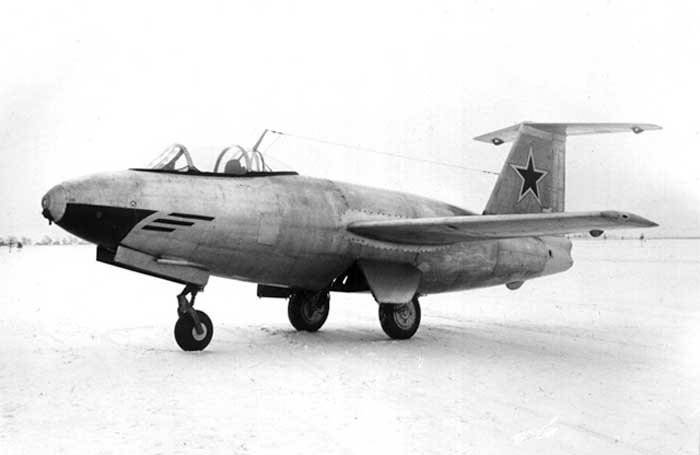
As shown by tests of scale models in the speed tube and partially flight tests of the I-300 (F) and I-250 (H), the designers planned to obtain with the 12% direct wing and selected profiles (TsAGI-1-1012 and TsAGI-12145) satisfactory torque characteristics of the combination "Fuselage-wing" to the number M = 0,85-0,9. In addition, in order to maintain satisfactory torque characteristics by reducing the influence of the wing on the horizontal tail, it was lifted by 1,2 SAX relative to the wing, and the tail tail was made T-shaped. Sweep horizontal and vertical tail was 20 degrees. The relative thickness of the horizontal tail profile TsAGI-08045 - 8 percent.
In the future, the straight wing was supposed to be replaced with an arrow-shaped one. The explanatory note to the conceptual design was noted: “... As soon as the blows enable the development of the swept wing, this aircraft will be replaced with the swept wing, which, with an increased Dushkin engine, will increase the speed of the aircraft in the horizontal plane and even exceed 1100 kilometers per hour ". The NII-1 plans for the 1946 year provided forcing the RD-2MZV to thrust 2 thousand kilograms.
The tricycle landing gear has a front support. Air-oil depreciation, release and cleaning of the chassis was carried out using compressed air. The track of the main stand was very narrow (1,60 meters), and retracted to the central part of the fuselage - special. niche under the wing between the frames №№ 10, 14. A niche of the nose rack, as well as two guns НС-23 and ammunition were located under the hermetic cabin. Power cab carried spets. 198A supercharger. To protect the pilot, the front armor plate was thick 8 millimeters and 15 mm armored glass. To save the pilot in an emergency, they planned to put a catapult seat on the car.
Special equipment consisted of: collimator sight PKI-1, radiocompass RPKO-10, radio station RSI-6, identification system "friend-foe" and oxygen device KP-14.
The power plant is a two-chamber liquid-propellant rocket engine RD-2MZV. Both combustion chambers were placed one above the other in the rear fuselage. The liquid-propellant rocket engine worked on a mixture of 96% percent nitric acid and kerosene, and the turbopump unit that supplied the oxidizer and fuel to the combustion chamber worked on 80% hydrogen peroxide. Stock of fuel components - 2120 kilogram. The fuel system consisted of three types of tanks: 4 acid (1620 kg), 1 kerosene (440 kg), 7 for hydrogen peroxide.
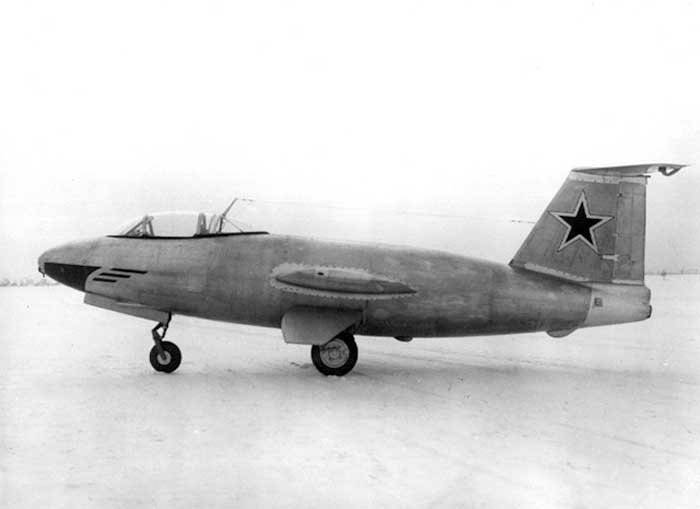
The on-board electrical system consisted of: a generator operating from a turbopump unit of a liquid-propellant rocket engine and a generator GS-1000, located in the forward fuselage, driven by a small two-bladed propeller and rotating from the oncoming air flow.
In the manufacture of the I-270 fighter, special attention was paid to protecting the structure from the damaging effects of nitric acid vapors. To this end, acid-resistant fittings and special anti-acid coatings were developed. Depending on the degree of the destructive impact of HNO3, the car was divided into four zones: the first - having the highest degree of aggressiveness at normal temperature, the second zone - also, but at elevated temperatures (from 110 to 150 degrees), the third zone - a smaller degree of aggressiveness, the fourth zone - the rest of the structure, which is exposed to aggressive environments.
All duralumin parts located in aggressive zones were applied several layers of protective coating developed at VIAM. The number of layers depending on the location of the parts reached nine. The application of the protective coating was carried out prior to installation on the aircraft. The design of the entire machine after assembly was additionally coated with paraffin-ceresin paste.
To control the state of the structure in the available places of the aircraft, so-called “witnesses” were installed, which consisted of three plates (one steel and two duralumin) with different coatings. The steel plate was galvanized, one duralumin was anodoxidized, and the other was coated with an anti-acid composition.
In accordance with the schedule for the design and manufacture of the item “F” approved by 15 in May, rollout to the airfield of the first instance was planned for 20.10.1946. However, due to the multiple reworking of the aircraft design, the working drawings were able to be completed only on October 2. By this time, the assembly of the head part of the fuselage and the pressurized cabin, intended for testing in the thermo-chamber, was completed, and the static tests of the tail assembly began.
The pace of work decreased due to the fact that the main workers and craftsmen were seconded to the aircraft factory No. XXUMX named after IV Stalin (Kuybyshev) to assist in the construction of the I-1 head series. Therefore, by the established deadlines, it was not possible to complete the assembly and transfer of the aircraft to flight tests. In addition, the enterprises of the fifth and eighth GU MAP supply of necessary instruments was disrupted.
Of the three flight copies of the I-270 interceptor fighter, two were built. The first to receive the ZH-1 index from the assembly shop rolled out the December 28 1946. The lead engineer Turchkov A.F. and test pilot Yu.V. Yuganov The supply of the flight engine was delayed. On the plane they installed a mock-up engine, received on October 21, which did not allow starting full-scale flight tests. Since there was no conditioned engine, the tests were divided into two stages.
At the first, “motorless” stage, the interceptor was towed behind a Tu-2 bomber. To carry out these tests, the aircraft was facilitated by removing all excess cargo: fuel tanks, dummy engines, weapons and power supply wiring. Towing tests "Ж-1" started 3 February 1947 of the year. Yuganov made the first 13-minute flight that day. The TU-2 towing plane No. 1041 was operated by test pilot Shelest I.I.
Before the glider tests were carried out preliminary preparation. The 11 and 13 of January were carried out by ground towing with the unhooking of an experienced interceptor at speed and approaching a height of about two meters. February 3 Yuganov made a training flight on the Yak-9, towed by Tu-2 No. 1041 as a glider. To simulate the characteristics of transverse and longitudinal stability, similar to the calculated characteristics of the new aircraft, the Yakovlev machine was loaded with lead blanks.
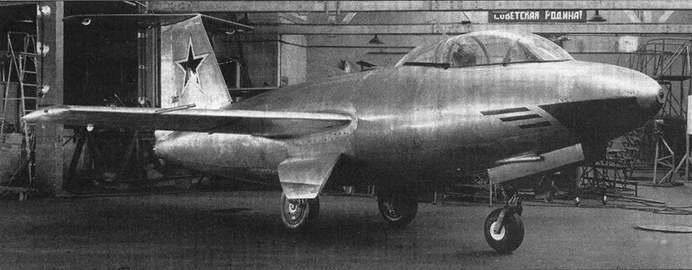
The I-270 and Tu-2 bomber uncoupling on tethered flights took place after a set of 5000-7000 m. After that, the experimental vehicle made an independent flight and the subsequent landing as a glider. On planning, we received the minimum instrumental speed of free flight 220 km / h and the maximum 600 km / h. The first stage of testing, which allowed to determine the characteristics of controllability and stability of the aircraft, maneuverability and remove the balancing curves, was completed 25 June. Made eleven towing flights with uncoupling.
On the next instance (ind. F-2) 8 in May 1947, the flight engine RD-2MZV was installed. This allowed to start the second phase of testing. Kovunovskiy N.I. was appointed lead engine engineer, and Lukashev A.I. 16 July as a mechanic when the engine was completed on the ground, a small camera exploded, which resulted in damage to the rear fuselage. The car went to repair, ended August 2. The test pilot lieutenant-colonel Pakhomov AK, attracted to the tests because Yuganov fell ill, performed two taxiing and approach on the “X-2” 26 of August.
The first independent departure fighter interceptor I-270 (ind. F-2) was held on 2 September 1947 of the year. The take-off with the engine running was normal, the plane reached 3 altitude thousandth. After that, the pilot, in accordance with the flight task, began to plan for landing, but due to an inaccurate calculation, with a large “overshoot” of the landing stops, he landed outside the airfield . 7-minute first flight was the last. The nose of the aircraft fuselage was broken, but the pilot did not receive injuries. The car did not recover.
Meanwhile, on the Zh-1, a standard engine was installed instead of a model engine, and on August 14 the plane entered the LII for on-the-fly tests. September 29 Yuganov taxiing, and October 4 plane was raised in the air.
During the flight, together with LII specialists, they measured the trajectory, rate of climb and speed of the I-270 interceptor fighter. To register the parameters, photographs were taken with two film assodites of the Ascania company, which were located at a distance of 1737 m from each other. The shooting speed was 4 frames per second, from the start to the engine shutdown.
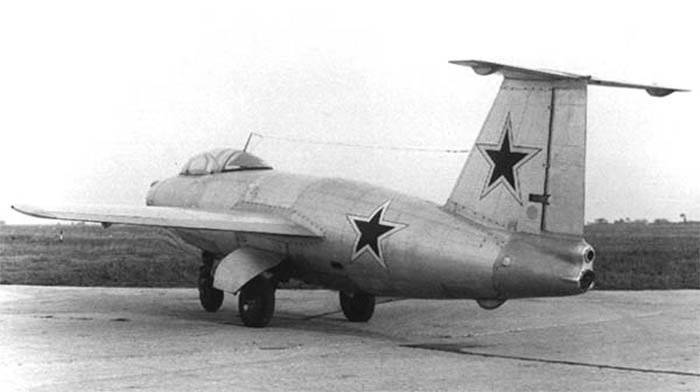
During the return to the airport to release it did not work. All attempts of the pilot to release him were not crowned with success. Yuganov decided to put the car on the fuselage. Having chosen a good place, he skillfully landed on a fairly limited area, due to which the car received minimal damage. Flight duration - 12 min.
After processing the information received, the testers obtained the following data: the time and length of the run-up amounted to 20 seconds and 697 meters, the separation speed was 233 km / h, the engine was turned off at 4450 altitude in 130,5 seconds, the speed at 2900 altitude m. at one o'clock.
The accuracy of the results made it possible to recommend the use of photo-kinetodoliths during flight tests to determine the vertical and horizontal projections of the trajectory, climb and speed, especially with unsteady flight mode.
Testers continued to pursue failure. For example, on October 21, after repairing the ground, a large chamber exploded when the engine was started, causing a nozzle to be thrown from a liquid-propellant rocket engine. Repair was completed on November 20.
E-270 (F-1) for the flight was fully prepared in January 1948. However, further tests were suspended. It turned out that the operation in winter conditions of an acidic liquid rocket engine had not been worked out.
After each flight, it was necessary to flush the system with water, and it was difficult to perform these works in aerodrome conditions in the cold. Also, for high-altitude flights there was inappropriate weather. Mikoyan, having coordinated the issue with Dushkin, ordered not to fly and stop the aircraft until March 1948.
The military provided close attention to the work on the I-270 fighter. From the middle of 1946, the order of new equipment, observation of the construction, as well as further testing of prototypes was carried out by the newly created aviation technical committee (ATK of the air force). According to the results of tests of the fighter-interceptor I-270 in March 1948, specialists of this department made the following conclusions:
- steel parts under the influence of acid fumes are highly corrosive, even despite the use of a protective coating;
- in flight, the engine cannot be restarted due to the danger of an explosion due to the probability of accumulation of acid in the engine chamber;
- the calculation of the landing of the aircraft without the engine running is difficult, because of its shutdown in the air due to the short operating time;
- water is used to neutralize the acid, which is unacceptable for use of an aircraft with such an engine in winter;
- strict adherence to instructions on the operation of acid tanks is necessary due to the strong effect of acidic acid vapors on the tanks (the acid tank ruptured during its pressure test after two months of operation on the plane);
- according to the instructions, after two months of operation of the tank on an airplane under acid fumes, it should be removed for a thorough check; since the acid tank had a large capacity, the work on its replacement on this aircraft design was very laborious;
- uniforms of technical composition used during the operation are cumbersome, inconvenient (jacket and trousers are rubberized), wear out quickly from acid (rubber gloves, boots).
The military was busy waiting position. On the one hand, the military did not want to get such an interceptor for armament, on the other hand they believed that the MAP needed to bring the RD-2MZV to a high degree of safety and reliability and continue the pilot operation of a rocket plane to gain experience.
After the reopening of the 31 aircraft in May 1948, test pilot Pakhomov AK made an 13-minute test flight that took place without incident. However, the Ministry of Aviation Industry did not want to “accumulate operating experience” of such unsafe equipment, and therefore the aircraft was no longer lifted into the air. The issue of non-compliance with a government resolution on 26.02.1946 by mutual agreement was no longer discussed.
The flight performance of the I-270 interceptor:
Wingspan - 7,75 m;
Length - 8,77 m;
Height - 2,80 m;
Wing area - 12,00 m2;
Empty weight - 1893 kg;
Maximum take-off weight - 4120 kg;
The mass of fuel - 2120 kg;
Engine type - liquid rocket engine RD-2М-3В;
Thrust - 1450 kgf;
Maximum speed at the ground - 1000 km / h;
Maximum speed at height - 936 km / h;
Flight duration at an altitude of 5 km in a small cell - 6,72 min;
Flight duration at altitude 15 km at maximum thrust - 4,15 min;
Maximum lifting speed - 4220 m / s;
Practical ceiling - 17 km;
Crew - 1 man;
Armament - two NS-23 guns of 23 caliber mm;
Ammunition - 80 shells.
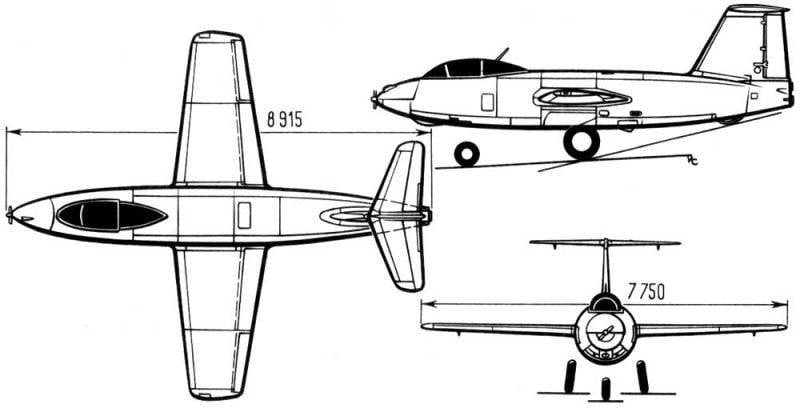
Information